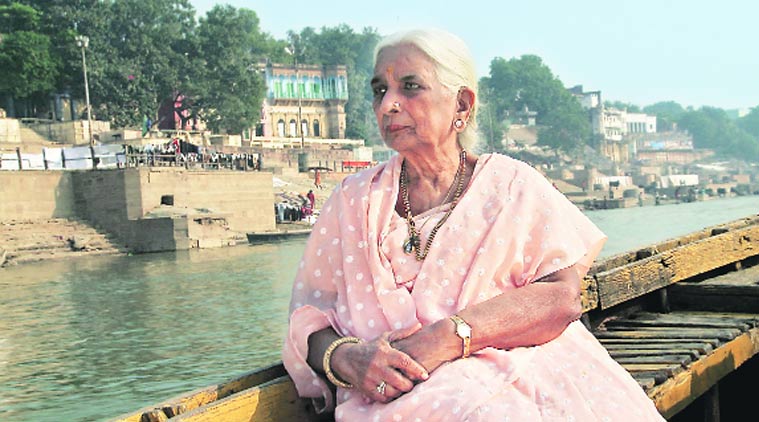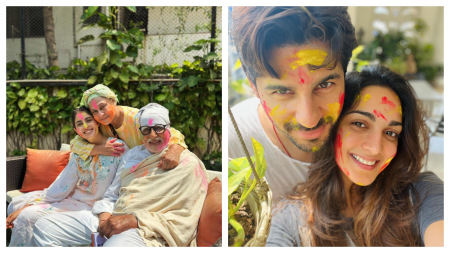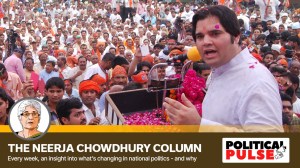- India
- International
The Endless River
A documentary on Girija Devi takes one through the narrow bylanes of Varanasi and the Purab ang gayaki they have harboured for decades.
 Girija Devi in a still from the documentary.
Girija Devi in a still from the documentary.
Through the labyrinthine lanes of Varanasi, steeped in spirituality and rituals, if there is one thing that has stayed alive for decades to become the soul of the city, it is perhaps the Purabiya lilt, the intonations of which can be heard through its famous thumris, chants at Kashi Vishwanath and through the famous Ganga arti. “There is a certain cadence to it. It really depends how much one can imbue in one’s words, feelings and songs, with truth,” says thumri exponent Girija Devi while chewing paan just before breaking into Basant ritu aa rahi, a thumri in raag Gandhar Bahar in the documentary titled Girija — A Lifetime in Music, which will be screened at India Habitat Center Sunday.
The notes in the thumri come with a unique sharpness in Devi’s mellifluous voice as she brings alive musical flirtations and the pain of unrequited love. It was this Purabiya style and the exactness of notes in Devi’s voice that had a young Madhu Chandra mesmerised at one of her famous Delhi soirees in the early ’60s. Now, almost half a decade later, Chandra, 67, has explored Devi’s contribution in the world of Indian classical music through Girija. The film is one of the two documentaries to exist on Devi, first one being a Doordarshan film.
The film opens with Devi listening to one of her older, complicated thumris on a gramophone. It then follows her music through Banaras and Calcutta and shows the colour and contours of her tunes through an exhilarating mosaic of images — while teaching her students, at concerts, in a grainy black-and-white Doordarshan video where she is seen crooning thumris while adjusting her pallu over her head, bringing to her rendition, a spectrum of emotions. “Ascent used to be on the raag. I tried to focus on words, too, so as to enhance their beauty melodically. A line such as Kaisi bansi bajayi shaam can be a lament, a question and an exclamation too. There can be three different ways of saying it,” says Devi in the film, the narrative of which moves along with the stories Devi tells, of her life and times. The film is also replete with interviews with Pt Ravi Shankar, Kishori Amonkar, Ut Amjad Ali Khan and Devi’s students.
Growing up in Banaras, singing shaadi ke geet for her gudiya ki shaadi, “music soon became like intoxication”. So much so that Devi got so busy perfecting her taans that she would forget about the chapatis she was cooking, burning many in due course. Not allowed to sing for Nawabs of the time by her husband, she began singing for radio and at conferences where she was much appreciated. Her musical journey and her brilliance found Dr Radhakrishnan, Sarojini Naidu, Jawaharlal Nehru and Indira Gandhi in the audiences in the ’60s and ’70s.
“I wanted to keep the focus of the film on music and not probe her much about her personal life,” says Chandra. Perhaps, which is also the reason why Chandra only sifts through discussing her music in terms of the country’s social and political context, something that creates a blindspot in terms of the Baiji culture that Devi came from. “Dwelling on that part of life would make her uncomfortable. I let her tell the story she wanted to,” says Chandra.

Devi’s story takes a different turn when she talks about leaving music after her husband’s demise in 1975, a time she took off her glittering nosepin and decided to take sanyaas. “She got back to it after many senior musicians coaxed her. Letting her leave it would have been a disservice to music,” says Chandra. And it’s here that, from the songs of desire, pain and prejudices, she finds spirituality, giving another dimension to her music and putting the prism of Purabiya lilt together without being a prisoner to the style.
She is seen teaching her students a thumri about a fish that’s just come out of water. “Uska dard gaane mein daalo,” says Devi in the film. “Without my music, that’s how I would be,” she concludes, looking away from the camera, as if going back into the bylanes of Varanasi where music spoke to her for the first time.
Photos
Apr 25: Latest News
- 01
- 02
- 03
- 04
- 05









































